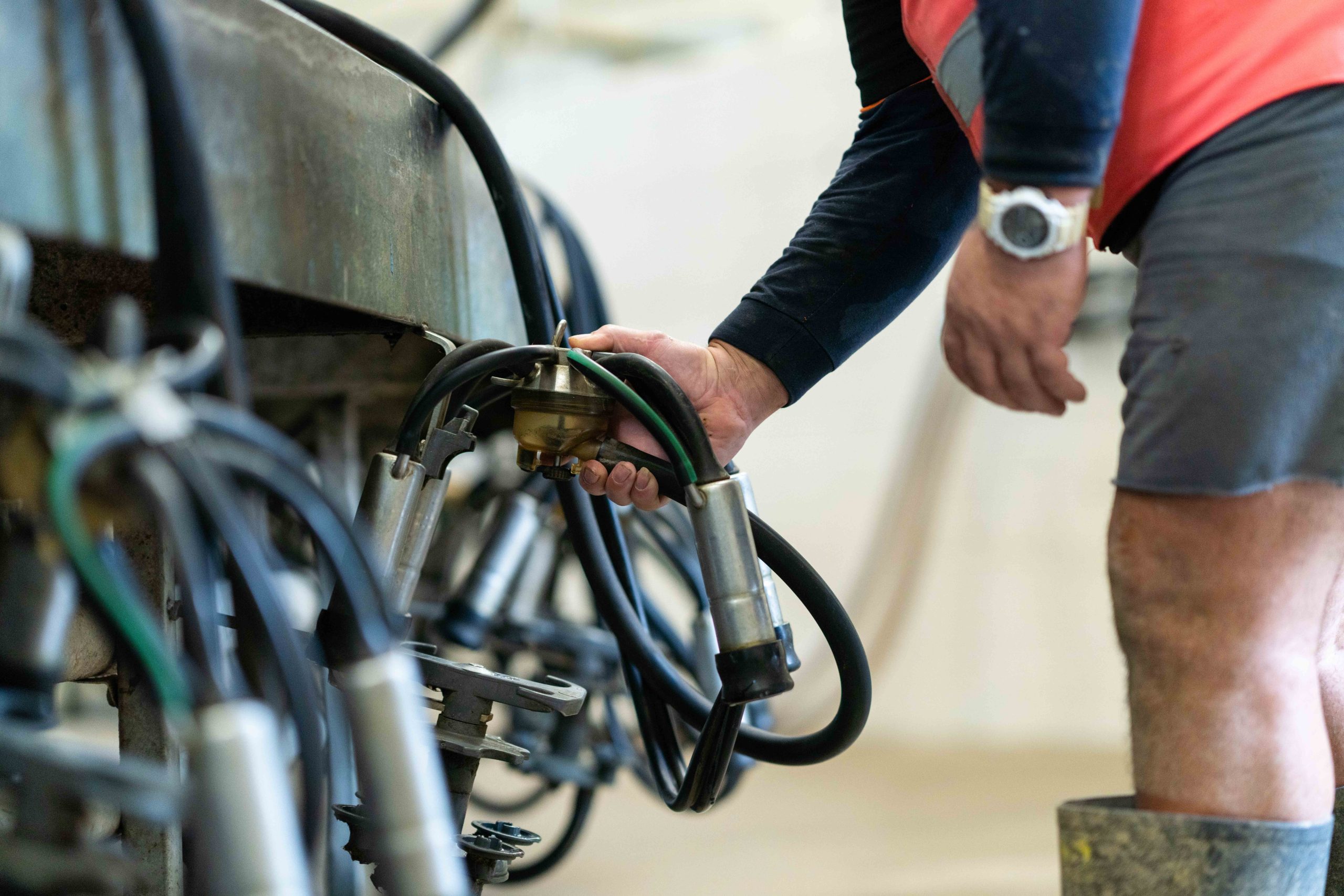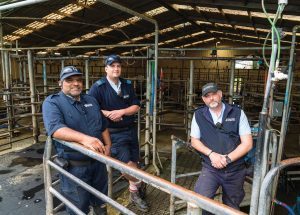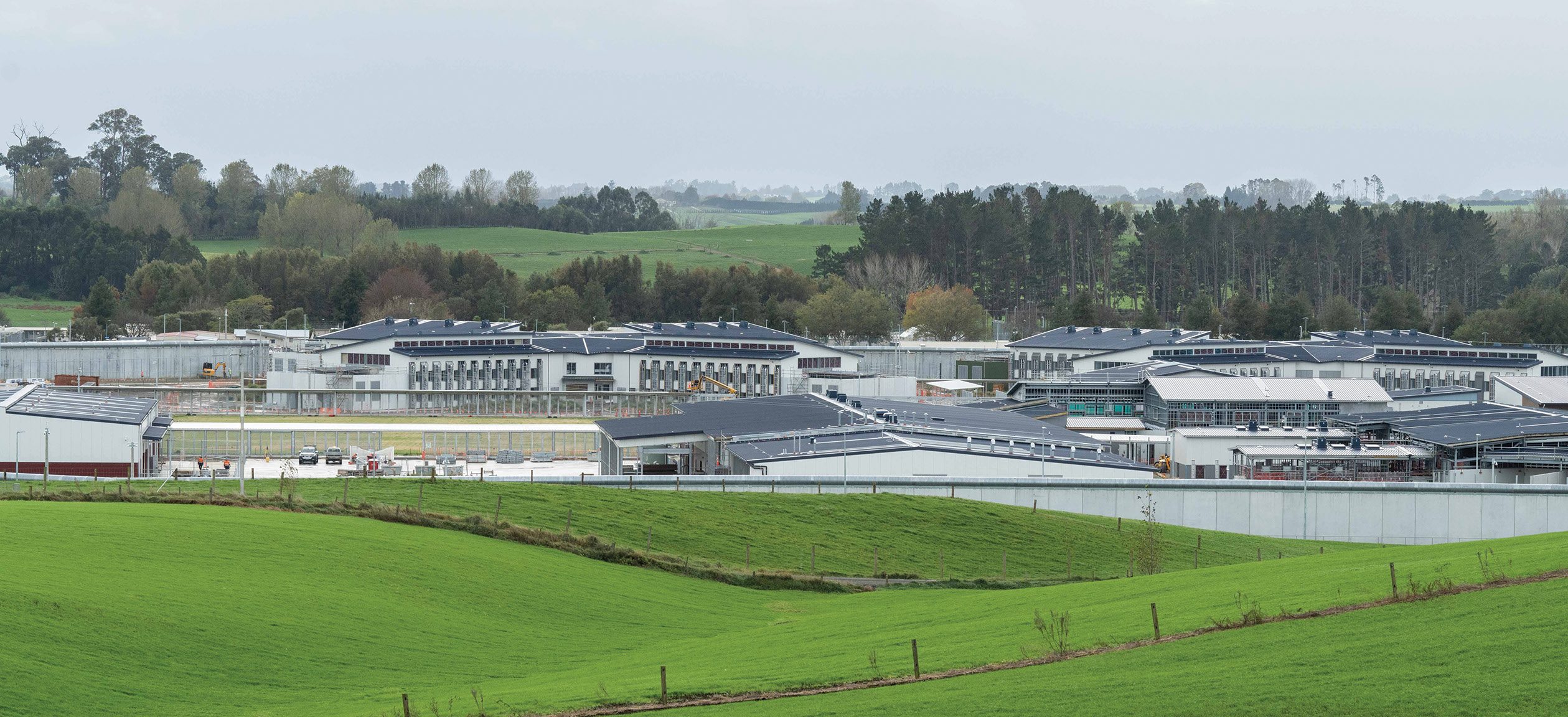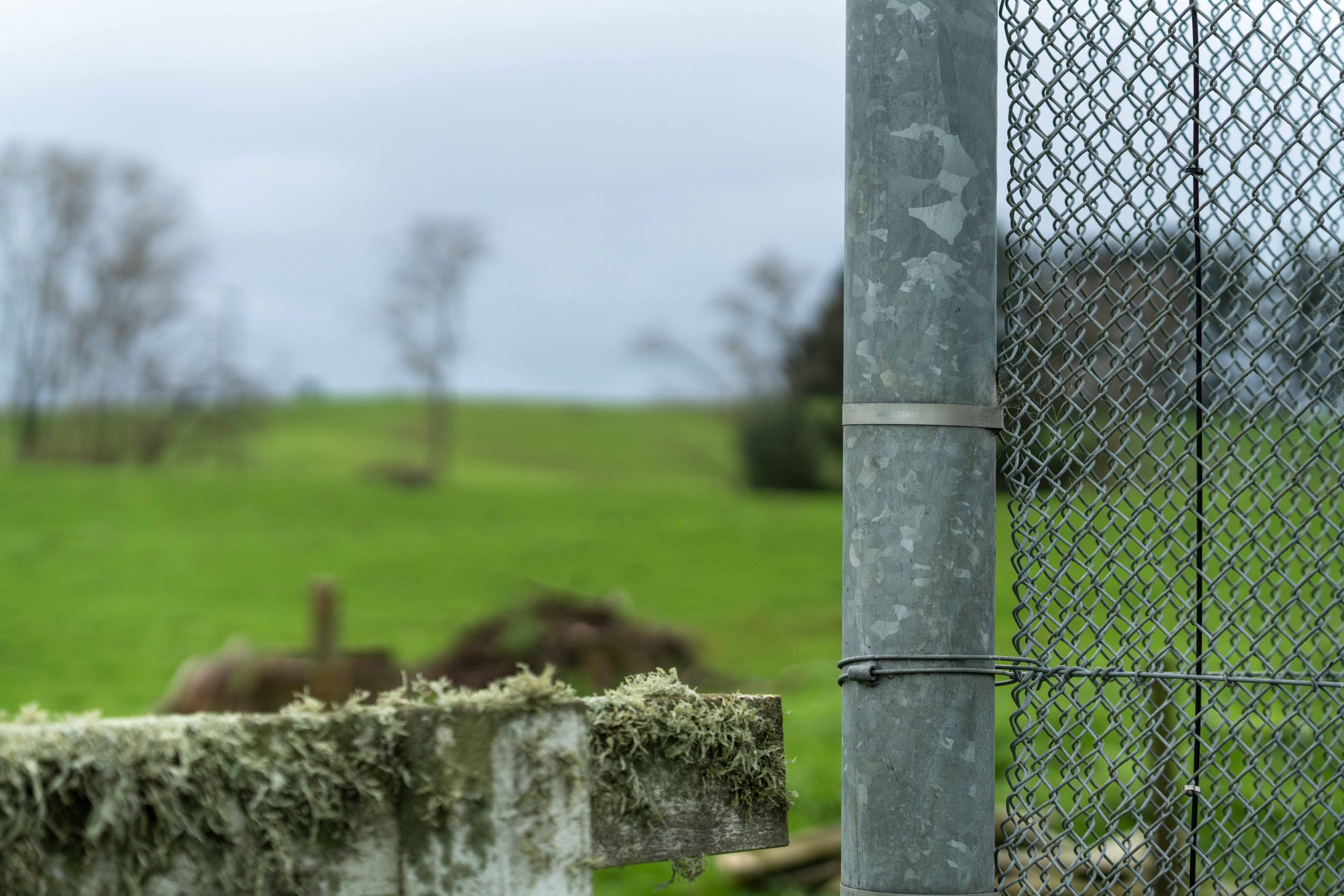Prison farm pivots from dairy to beef
Waikato’s Waikeria Prison farm has been operating for 110 years and thousands have been through the farm training system. Once a sheep farm, the prison farm converted to dairy and is now pivoting to focus more on beef production. By Claire Ashton
Photos: Emma McCarthy

Waikeria Prison farm has been operating for 110 years and thousands have been through the prison farm training system. Sheep farming was the main focus for the Waikeria Prison Farm until it started to be phased out in the late 80s. The dairying operations at Waikeria began in the 1950s, and in the late 1990s they were milking in excess of 4000 cows through 4 cowsheds.
Since 2010 this has gradually been reduced until the coming season (2023/24) when about 900 cows will be milked at Dairy 1, a 60 bale rotary dairy shed. In 2018 they decommissioned Dairy 2, an older herringbone shed, which will now be demolished.

Dairy 3, a rotary shed will be mothballed. Part of the reason for drying off Dairy 3 was due to the impact of Covid. If prisoners and staff tested positive and had to be isolated, it impacted the rosters and staff levels onfarm, halting the Dairy3 operation.
Dairy 1 produces about 950kg MS/ha on the OAD system. This represents a drop in production of about 25-30% from twice a day milking, however gains are made in other areas which partially offset the difference.
These gains are around a well-rounded prisoner education programme which is the primary purpose of the prison farm. On OAD prisoners have more time to learn skills other than just milking.
ONCE A DAY MILKING SUITS TRAINING
Waikeria prison farm principal instructor Luke Jago notes that the main driver at Waikeria prison farm is not production based, it is principally a training farm, and animal health and welfare is a priority. For this reason they run a once-a-day (OAD) milking regime and a System 2 and they grow all feed on farm. Production figures are pretty good for an OAD system and when changing to this system in 2017, they didn’t see a huge drop in production.
They breed from OAD sires, and since going OAD, they have found that lame cow numbers have been reduced significantly.
Prior to that, they had a regular weekly vet visit for around a dozen cows with lameness issues. On OAD milking the first season, Stewart recalls that they had the vet just four times over one season, thus the visits were more sporadic and primarily for one-off issues.
Somatic cell count numbers lowered significantly on OAD which goes against some thinking that somatic counts and mastitis issues will increase on OAD.
Seasonal SCC rates currently sit at 150,000 – 190,000. Under the old twice a day model there was an annual average of around 250,000 – 280,000.
Reproductive rates improved and empty rates decreased. Reproductive rates for the cows have remained reasonably constant at between 9 and 12% for a 9-week mating period under both systems. On Dairy 3 they had an 8.9% empty rate for the year.
Luke has also observed that on OAD the cow’s grazing patterns change. On twice a day milking the cows would go in and strip a paddock in a couple of hours, on OAD they graze less aggressively.
Waikeria prison undertake farm planning with consultant Mike Bailey from Farmwise.
Their primary goal is to reduce dairy stock numbers and refocus on dry stock which is in line with endeavouring to reduce GHG emissions through downsizing of their dairy herd. As part of the transition, cows were dried off and culled which then created further drivers towards beef stock. They took the lowest producing cows, who were in calf to Herefords and left the calves on the cows, with weaning not taking take place until five or six months old.
A handful of Jersey bulls are kept on farm and the prison farm rears replacement heifers and buys in Hereford bulls for tailing off. The past clear delineation of herds and farms is blurred by the lopsided calving patterns. They took the herds from Dairy 1 and 2 and got the best of them both, breeding from the top cows.
Selling beef cattle is now part of the farm operations, with 1350 drystock on farm, and when Dairy 3 is included, that will put stock numbers up to around 2000, with 500 additional beef calves this season.
Stewart Morgan says the beef cattle run under a regular programme of weighing, drenching and monitoring the stock. All animals are measured routinely and the results recorded in the Datamars system.” We would anticipate that under the beef farming model there is more time available in the day to achieve training than there is for those committed to a daily milking routine.”
“A big thing when they come out here for the prisoners is the rehabilitation and reintegration. It sort of changes their mindset.”
“They can spend years in prison and then come out here and it’s the first time not having a grille in front of them. They go from seeing a cow for the first time to milking it, to feeding them and then going on to employment on the outside.”

FARM INSTRUCTORS WEAR MANY HATS
The prison has 10 farm instructors, with five on each work area. The farm is advertising for another prison farm instructor, and they are in the same boat as others in the dairy industry when it comes to labour – it is a challenge to fill the position. Five days on, three off, with a 10-hour day worked should be a drawcard. As prison farm instructors they wear three hats; one is custodial, as prisoners are in their custody; one is industry-based, as they are farmers; and the third is as teachers,
being trained primary ITO assessors. The Principal Instructors’ days and hours will now match the Principal Correction Officers’ Monday to Friday work week on the floor.
Stewart has driven the initiative as the three days off could fall during the week which meant Principal Instructors were less involved in decision-making and processes onfarm.
The instructors come from a variety of backgrounds and there are different pathways to working in Corrections.
Luke is a former sharemilker, Peter was relief milking and has been on the prison farm for just eight months. Sanjeet has been there for 13 years and is from the South Island. From Fiji originally, he was a high school science teacher in a past life.
Mike Bailey has been the prison farm consultant since 2014. He says it is an interesting farm to work with as it is always undergoing change and the focus is on education.
“Everything we do has an education slant on it,” Mike says. “The prison does not have your regular staff, or reporting.”
Being a government department, reporting is an integral part of the farm management, and with the recent shift to drystock, the changes have meant that wrangling farm data and statistics can be challenging.
“One of the challenges is for us to be able to model the economic changes – it’s difficult,” Mike says.
 Rebuilding a life
Rebuilding a life
IT IS UNFORTUNATE THAT WE can’t photograph former inmate Semisi, now on probation, as the sheer wattage of his smile brightens up the grey day on the grounds of Waikeria Prison.
“It still feels like a dream, getting out of bed in the morning. It feels like this is how it should be – with my wife and family.”
In 2011, Semisi formed a writing relationship with the woman who is now his wife, who he says keeps him grounded, along with her church faith.
“A gang affiliation is what got Semisi into trouble and was behind his offending and got him here in the first place. His wife has been a positive influence on him,” Stewart Morgan, Manager of Industries notes.
As a ‘lifer’, probation terms for Semisi means meeting his probation officer fortnightly to check in and communicate what is going on with him, and if he is facing any issues or challenges.
Now married with children, he travels from Hamilton to the prison daily to work in construction of the new prison build, which will provide 600 prison beds, 100 of which will make up the Hikitia unit for mental health and addictions.
Waikeria lost about 300 beds in the old block during riots two years ago, and that building has now been demolished and the area will be returned to pasture.
“I like the physical side of building, just like the farming which I started in 2022, having never worked on a farm before. I was taken through a farm training programme that included health and safety and I started in the shed and learned by watching the prison instructors,” Semisi says.
The main point of difference with Waikeria prison farm is that it exists to train prisoners in farming. Despite the perceived ‘cheap’ or ‘free labour’ the inmates provide, the five prison farm instructors required per shift negate that. Stewart and Luke Jago, Principal Instructor, are proud of the work they do training inmates.
“There is a misconception that the farm is making all this money as we have free labour. But actually, each of the farms employs five farm instructors per unit, so the labour costs are more than an external farm as we have custodial responsibilities.”
The prisoners have to be on a low or minimum-security risk to be eligible to go onfarm. As part of the prison farm programme, inmates get inducted into health and safety protocols, and vehicle use. Semisi particularly enjoyed calving and assisting cows if they got into difficulties.
“Calf rearing was a job I liked – getting the calves to feed, and their playfulness, like when they would follow me around and head-butt me.”
All the usual aspects of farming such as milking, fencing, setting up breaks, and spraying weeds are covered within the programme which sees prisoners obtain a Primary ITO level 2 certificate in New Zealand Primary Industry Skills Agriculture (Dairy Farming). The usual time frame for this course is seven months.
There are no dogs on prison sites, and onfarm they drive light utility vehicles (LUVs). There is no mechanical training in terms of fixing things, but Stewart adds that “Semisi did learn a bit about breaking things.”
Laughter follows this, and they acknowledge this is all part of onfarm training – owning up to and learning from mistakes.
“I have learnt a lot onfarm about communication and teamwork, and admitting when you make mistakes,” Semisi says.
“We consider ourselves a training institution and a certain amount of wear and tear is expected and there is a certain amount of risk,” Stewart says.
Now working in construction and concreting, Semisi doesn’t rule out returning to dairy farming in the future, however, is loyal to his current employer Silver and Co, a contracting company on the new build. He didn’t mind the early starts when working onfarm, and Semisi formed a habit in prison which he still follows, getting up at 3am most mornings to stretch. Looking after his body and his health is a priority – he was overweight when he entered the prison system, weighing about 180kg – but prison helped him focus on nutrition through healthy eating, and later by learning to shop and cook.
Playing for the Hamilton Tigers rugby league team is another opportunity for Semisi, and the practices and training sessions keep him fit, along with gym sessions, and form another means of connection with others – even his current boss comes along to watch the games.
Before entering prison aged 19, Semisi was a forklift driver, having left school at 15.
Seeing a private counsellor for four years helped him to address criminogenic behaviours (causing or likely to cause criminal behaviour).
The prison farm is one of the last steps in rehabilitation, first of all the prisoners’ primary needs have to be met and progressed through.
Numeracy and literacy were a first priority. When Semisi entered prison, he was around a level 2 in NCEA college standards, and wanted to get up to a level 3 before he started working.
“Before, I was anti-social and didn’t want to talk about emotions, I wouldn’t be able to do an interview like this,” Semisi says.
“As a senior member of the team, Semisi was a role model or mentor for some of the young guys in prison – he’s been around and knows how the system works,” Stewart says.
Each prisoner has a case manager who manages their sentence, and identifies criminogenic needs, education needs, and rehabilitation needs, and then pick up on their history and background. There is an advisory panel process and each prisoner who wants to, or is asked if they want to work onfarm is assessed on a case-by-case basis. Their history of behaviour and compliance is looked at as well as attitude for their eligibility, and proximity to parole date. Prison farm workers don’t leave the prison property and are not directly supervised all the time as they may be out bringing cows in or winding up a fence, so they do have a certain amount of autonomy to work on their own.
RELEASE TO WORK
Since the onset of Covid, the Release to Work (or RTW) scheme has been primarily focused on the construction on site. Prior to that prisoners were externally released to dairy farms and other businesses and staff would drop them off and pick them up.
Staffing issues have meant that the necessary staff aren’t available so it is uncertain if this RTW farm scheme will restart. Once on RTW prisoners have more freedom. Waikeria is ‘fully operational’, which means in-person visits in weekends, and zoom calls are on the go.
“When you look at the variety of prisoners’ backgrounds, some have arrived with onfarm experience and have shared that knowledge with fellow prisoners and staff.”
Stewart says that they have had some experienced farmers come through the farm; including one who had worked on a Landcorp farm, and others have included farm owners and sharemilkers.
 Getting a chance and getting ahead
Getting a chance and getting ahead
UNFORTUNATELY, THERE IS limited data collected about prisoners upon release to see if they have gained successful employment.
One undeniable success story however is Ben Purua, who has returned to Waikeria a few times to talk at the Waikeria Prison Farm Open days. He has talked to prisoners and potential employers about employing men once they are released. It meant a lot to Ben to go through the onfarm training at Waikeria.
“It’s a hard process to get on to programmes outside of the wire. So, when I finally was approved, I was really happy to finally be able to get out of the unit.
“It wasn’t until a few years later when I was farming, I reflected on that experience and realised how valuable the learning was for me,” Ben says.
With his criminal conviction, Ben struggled to find employment, but he was given a chance and has gone on to prove his employability and then some.
“I found finding work really hard because I had a criminal conviction and I struggled on the best way to disclose that. Whenever it came up in an interview, I knew I would not be receiving a call back.
“I knew I had the skills so I have always looked for an employer that would accept me and offer me a chance.
“My first break came on a bull farm and I was employed by Roger Wolf and Tyree O’Connor. This allowed me to put my skills into practice. When I moved on to dairy farming, I had another two great employers on my journey – Graeme Lucas and Shane Robinson.”
Ben is now farm manager at Waimakariri Farms, has become a mentor for Primary ITO, is director at FarmUp NZ, and is a council member for the Food and Fibre Youth Network. There is the recognition too; he was the Young Maori farmer finalist in 2021 for the Ahuwhenua Trophy.
Ben is living proof of how the prison farm training programme can set pathways. Mahi tahi is a new course initiative being provided internally by Corrections, aimed at giving a view of life and work from a Maori cultural perspective.
“We have guys who leave the farm and a few months later an employer rings to reference check them. We had a guy here for seven months during calving season and then moved through to Release to Work for a few months. I had a call recently about him and I am happy to provide a reference. By the time they leave they are fully competent farm assistants – some are close to a 2.I.C with their skill level. Coming from sharemilking myself and hiring guys, I would be quite happy hiring them,” Luke says.
The prisoners learn a lot of soft skills through the onfarm programme such as communication, and the routine of work. Some may have never worked or even observed someone working before. Just getting out of bed in the morning and going to work, are all skills being instilled.
“Farming is a really positive influence on the prisoners, and Waikeria Prison wouldn’t give a reference if we didn’t think the guy was suitable,” Luke says.
The other asset the workers gain is recognised farming qualifications (Primary ITO level 2) and their ticket on the LUV (light utility vehicles) so they are ready to go. With farm workers, the worker may be living in a farmhouse onfarm. The prison instructors take this into account and are judicious about who they would place somewhere. The elephant in the room? What did they do?
The prison cannot supply that information. Luke and Stewart say 99.9% of the time the prisoner will be honest and upfront about the crime committed with a prospective employer.
AT A GLANCE
Wetlands
In 2018 construction began on the new prison build to replace and improve on the old block which was burned down during prison riots. The farm undertook a riparian planting programme, which in part is mitigation planting for resource management to provide a planting shield for neighbours and is ongoing. Farm waterways are very clean and boast a healthy indigenous biodiversity; one being the robust eel population, which the prisoners feed bread.
Fencing
A lot of the fencing onfarm is old and dates back to when the prison was a sheep farm in the mid-1990s. Part of the prison farm training is fence remedial work.
Crops
Land is leased to a local contractor who grows maize for grain. Turnips are planted on the dairy block. There was a lot of grass around this year due to the rain. Corn maize got left on the ground following Cyclone Gabrielle and some maize is popping up throughout the paddocks.
Pine Block
The onfarm 15-year-old pine block was virtually destroyed by the cyclone, with the trees snapped right off near the top. On the morning after the cyclone Stewart noticed that the area was a lot lighter. “It was a bit of an apocalypse,” Stewart says.
Trees fell on power lines and cut power to the prison, so they had to fell a block of pines to ensure that wouldn’t happen again. The area will be replanted. The prison grows its own native seedlings, wth 700,000 raised in the nursery. The prisoners do not learn forestry skills onfarm but do learn chainsaw skills.
History
In the past meat and milk from the prison farm would be used in the prison and it even had a milk pasteurising plant, but the cost of compliance and regulations including a standardised national menu for all New Zealand prisons saw an end to ‘paddock to plate’ on farm products.
As no guns are allowed on site the prison farm is a bit of an animal sanctuary, and turkey and fallow deer roam paddocks with the deer often spotted close by. There is an urupa on the prison farm that dates back to the Waikato Land Wars, with possibly 400 bodies buried in the area which is covered with native bush. Planting has been done carefully to provide coverage around the boundaries and treat the area with respect.
Ballance Farm Environment Awards 2019 AWARDS RECEIVED:
Bayleys People in Primary Sector Award
Synlait Climate Stewardship Award
Waikato River Authority Catchment Improvement Award
History
Dairy units 1,2 &3
More recently, two dairy farms milked up to 1800 cows.
At one time there were four dairy sheds milking a total of 4000 cows twice a day.
Current Dairy 1: 307 ha, 60-bale rotary shed operational milking around 980 cows OAD.
Dairy 2: herringbone shed has been closed since 2020 and scheduled for demolition.
Dairy 3: rotary will be mothballed.





